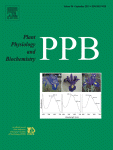Ver ítem
- xmlui.general.dspace_homeCentros Regionales y EEAsCentro Regional Patagonia NorteEEA BarilocheArtículos científicosxmlui.ArtifactBrowser.ItemViewer.trail
- Inicio
- Centros Regionales y EEAs
- Centro Regional Patagonia Norte
- EEA Bariloche
- Artículos científicos
- Ver ítem
Melatonin in Arabidopsis thaliana acts as plant growth regulator at low concentrations and preserves seed viability at high concentrations
Resumen
Since the discovery of melatonin in plants, several roles have been described for different species, organs, and developmental stages. Arabidopsis thaliana, being a model plant species, is adequate to contribute to the elucidation of the role of melatonin in plants. In this work, melatonin was monitored daily by UHPLC-MS/MS in leaves, in order to study its diurnal accumulation as well as the effects of natural and artificial light treatments on its
[ver mas...]
Since the discovery of melatonin in plants, several roles have been described for different species, organs, and developmental stages. Arabidopsis thaliana, being a model plant species, is adequate to contribute to the elucidation of the role of melatonin in plants. In this work, melatonin was monitored daily by UHPLC-MS/MS in leaves, in order to study its diurnal accumulation as well as the effects of natural and artificial light treatments on its concentration. Furthermore, the effects of exogenous application of melatonin to assess its role in seed viability after heat stress and as a regulator of growth and development of vegetative tissues were evaluated. Our results indicate that melatonin contents in Arabidopsis were higher in plants growing under natural radiation when compared to those growing under artificial conditions, and its levels were not diurnally-regulated. Exogenous melatonin applications prolonged seed viability after heat stress conditions. In addition, melatonin applications retarded leaf senescence. Its effects as growth promoter were dose and tissue–dependent; stimulating root growth at low concentrations and decreasing leaf area at high doses.
[Cerrar]

Autor
Gatica Hernandez, Ismaél Jairo Gabriel;
Gomez, Federico José Vicente;
Cerutti, Estela Soledad;
Arana, María Verónica;
Silva, María Fernanda;
Fuente
Plant physiology and biochemistry 94 : 191-196. (September 2015)
Fecha
2015-09
ISSN
0981-9428
Formato
pdf
Tipo de documento
artículo
Palabras Claves
Derechos de acceso
Restringido
 Excepto donde se diga explicitamente, este item se publica bajo la siguiente descripción: Creative Commons Attribution-NonCommercial-ShareAlike 2.5 Unported (CC BY-NC-SA 2.5)
Excepto donde se diga explicitamente, este item se publica bajo la siguiente descripción: Creative Commons Attribution-NonCommercial-ShareAlike 2.5 Unported (CC BY-NC-SA 2.5)

